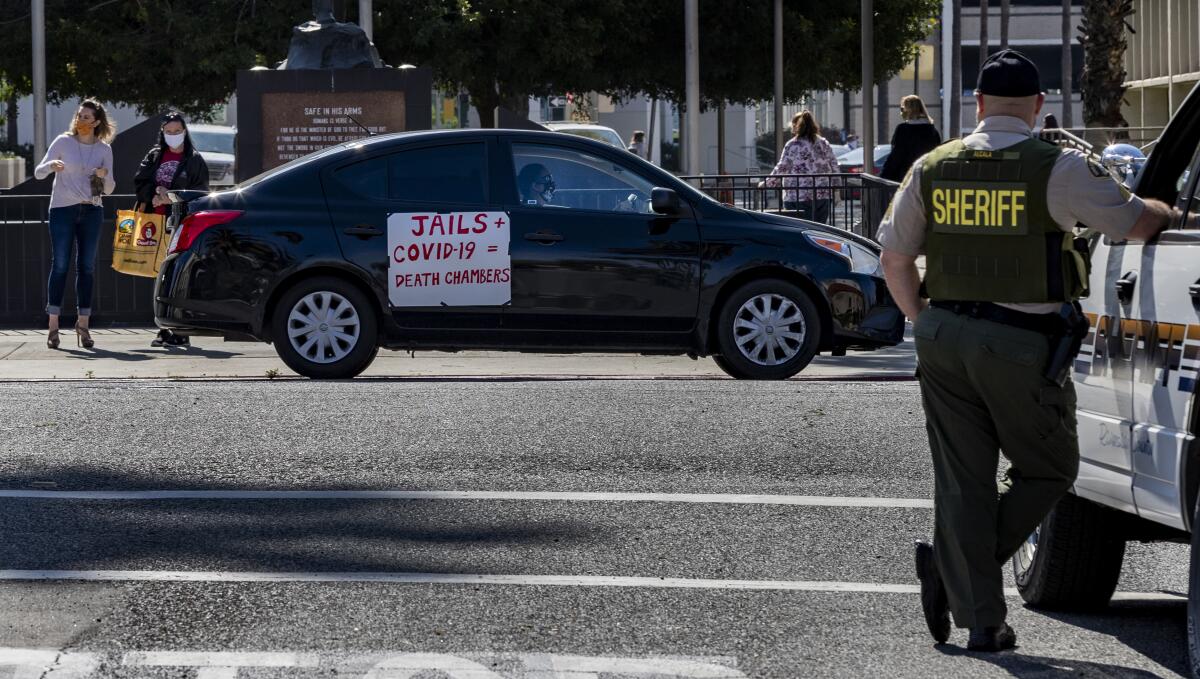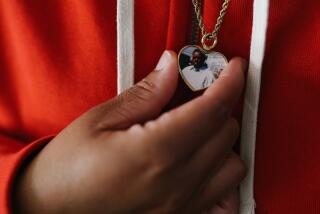Second Riverside County inmate dies after testing positive for COVID-19

- Share via
A Riverside County jail inmate who tested positive for COVID-19 died Tuesday, marking the second coronavirus-related inmate death in three days.
The back-to-back deaths come as the Sheriff’s Department is facing questions from civil rights attorneys and activists about its efforts to protect people who live and work in the jails.
As of Wednesday, 141 inmates have tested positive for the virus and most have recovered, according to the Riverside University Health System-Public Health. The Sheriff’s Department has not provided a breakdown of coronavirus cases at each of the jails it runs.
Tuesday’s death came a month after the inmate, identified as Salvador Garcia, 57, was booked into custody at Southwest Detention Center in Murrieta. He was arrested March 27 on suspicion of domestic violence and 10 days later taken to a hospital for treatment of a preexisting medical condition. At the hospital, the man came down with flu-like symptoms and on April 15 tested positive for the coronavirus.
Authorities have not determined a cause of death but said it appears to have resulted from complications from his preexisting condition, possibly exacerbated by COVID-19.
The previous inmate death occurred Sunday. The man, identified as Edward Clark, 69, had been in custody since August 2018 on burglary and arson charges. He was housed at Larry D. Smith Correctional Facility in Banning in lieu of $1-million bail. He came down with flu-like symptoms on April 13 and tested positive the next day, the Sheriff’s Department said. Six days later, his symptoms worsened and he was taken to a hospital.
The department has not released new figures on infected employees since April 17, when 71 had tested positive for the virus. Two deputies — including one who worked in the Murrieta jail — have died.
Civil rights advocates have described the agency’s efforts to protect people who live and work in the jails as woefully inadequate. Inmates have said they feared their jail terms could turn into death sentences. Deputies worry about bringing the virus home to their families.
A federal judge found that the Sheriff’s Department “failed to demonstrate that it is currently taking adequate precautions” to protect those in custody and ordered officials to submit a plan to achieve physical distancing.
The Sheriff’s Department has not made public plans it submitted after the judge’s order.
Early on, Sheriff Chad Bianco generally spurned the broad early release orders adopted by other law enforcement agencies to slow the spread of the virus behind bars.
In a court filing, the department said it already was releasing low-level offenders to ease overcrowding, including those who would otherwise qualify for compassionate release or who are at high risk of contracting the virus. It’s unclear what criteria it uses for those releases.
“There is no such thing as a low-level inmate in our custody. We don’t hold them anyway,” Bianco said during a news briefing this month. “If you don’t want to catch this virus while you’re in custody, don’t break the law.”
Jordanna Wong-Omshehe of Starting Over Inc., which provides reentry services, said she and other activists had been urging Bianco to reduce the jail population since mid-March.
“This all could’ve been avoided,” she said. “Why are people being booked? Why aren’t alternatives to incarceration being utilized? ... Regardless of what they’ve done, they did not deserve to die in jail.”
Wong-Omshehe pointed to Los Angeles County, which has more than triple the jail population but fewer coronavirus cases, as evidence that releasing older people, those arrested for nonviolent offenses and in other categories helped slow the spread of the virus. L.A. County jails, which typically house 17,000 inmates, now have fewer than 12,000 in custody. As of Wednesday, 107 inmates had tested positive.
In Riverside County, 141 inmates have tested positive. The jail population has dropped to 3,230 from about 3,700. Differences in the rate of testing, however, were unclear.
Some critics have argued that L.A. County has not done enough. A class-action lawsuit filed last week claims that inmates are not being tested even when they show symptoms and lack sufficient space for physical distancing. The lawsuit says inmates don’t have enough soap or a safe way to dry their hands.
One of the plaintiffs named in the case is Rodney O. Cullors, 58, who is housed at Men’s Central Jail downtown. The lawsuit says that he suffers from several severe ailments, including heart problems, spinal damage and schizophrenia. It claims that nearly 100 people are forced to live in the same open dorm unit where dozens of triple bunk beds are placed one to three feet apart.
In March, Cullors was taken to a medical appointment and spent 30 to 45 minutes exposed to a patient infected with COVID-19 “without any mask, gloves, or even a dividing curtain,” the lawsuit says.
It seeks the release of medically vulnerable individuals and requests the L.A. County Sheriff’s Department implement a list of preventive measures, including temperature checks and screening for all new bookings, free soap and paper towels to allow frequent hand washing and drying each day, an adequate supply of disinfectant hand wipes and multiple face masks that are regularly cleaned.
When asked about the lawsuit at a news briefing Monday, Sheriff Alex Villanueva said that he had not been served but that the agency has depopulated by more than 5,000 inmates.
“Our goal was to create defensible space so we could do some social distancing, we’d have the room to move populations, to quarantine, isolate where needed,” he said. “The system we put into place was intentional from the very beginning, but we have to balance the public safety of the community outside the jails versus those inside the jails and those who work in the jail system.”
Villanueva said releasing the number of inmates needed to achieve CDC-recommended social distancing guidelines behind bars would be “physically impossible.”
“You’d be putting out onto the street people that you would not want to see out on the street,” he said.
More to Read
Sign up for Essential California
The most important California stories and recommendations in your inbox every morning.
You may occasionally receive promotional content from the Los Angeles Times.











